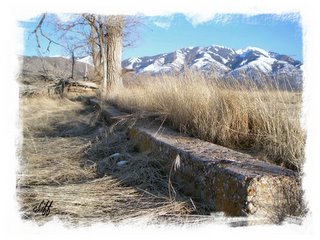 DESOLATION
DESOLATIONLooking at Skull Valley, I see some harsh ground for Utah. It's just southeast of the Bonneville Salt Flats and next to the top secret Dugway Proving Grounds -- a part of Utah that is sparsely populated to say the least. The little water in the area seems to be frozen in the mountains or under ground. Wikipedia describes the valley this way, “Considered an unsuccessful attempt at colonization, Iosepa was an extremely inhospitable location for any group of people.”
But the Hawaiians wanted to be next to the Salt Lake Temple, so I guess Skull Valley, 75 miles out, was reasonably close. I suspect there were other reasons. After all, at the time there was a temple in St. George, a much warmer area but which already had a colony. There was another in Logan and one in Manti, Utah.
I suspect that it wasn’t being close to just any temple but rather the Hawaiian saints wanted to be by Elder Smith, Elder Cannon and other senior authorities at the Church office in SLC.
A BAD NAME TOO
 The colony was named after the Apostle Joseph F. Smith, who served his mission in the Hawaiian islands. They supposedly gave it the Hawaiian name for Joseph -- Iosepa.
The colony was named after the Apostle Joseph F. Smith, who served his mission in the Hawaiian islands. They supposedly gave it the Hawaiian name for Joseph -- Iosepa.Iosepa?? What’s that? The Hawaiian language doesn't have an "s" in its alphabet. "Iokepa" would be the appropriate transliteration of Joseph's name into a Hawaiian pronunciation. "IoSepa" sounds like a bunch of haoles (white guys) slurring the name back to English, sort of a second generation transliteration. e.g. Joseph > Iokepa > Iosepa > And even this distortion is further distorted by being given an Anglo pronunciation, Yo-seh-pa. Matthew Kester of BYU-Hawaii states that Hawaiians were more literate than their Caucasian counterparts at the time. They certainly knew how to read and write their language. Their church leaders also preached in Hawaiian. In other words, the Hawaiians of "Iosepa" knew how to write their language in 1889 just like we know that Lisa is not spelled "3-I-S-A." It's a real indication that the feedback mechanisms to civic leadership were not fully working.
The fact that the Hawaiian saints let the spelling stand meant that they understood the ignorance of the surrounding culture and their civic leaders but went along out of respect for authority. I can't come up with another conclusion than that. For the record, Iokepah is pronounced EE-OO-KE-PAH. The wrong name and pronounciation is but another tangible evidence of Utah haoles trying to make sense and to nurture what they didn't understand. The results of everyone’s efforts are the graves on the ghost town of Iosepa in the desolate Skull Valley.
HAWAIIANS FAILED BECAUSE NOT INDUSTRIOUS?
There are some here that think their brown brothers failed because they simply could not work as hard as the other colonists throughout Utah. One web site author writes,
“The Kanakas were not used to the hard labor necessary to create a colony which was to survive on its own. Although they managed to get by most of time, much of their food was imported from Salt Lake City.”Historian Arrington seems to anticipate this stereotype and responds:
